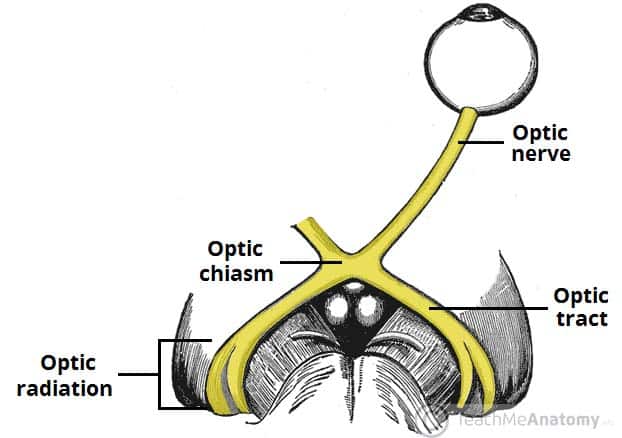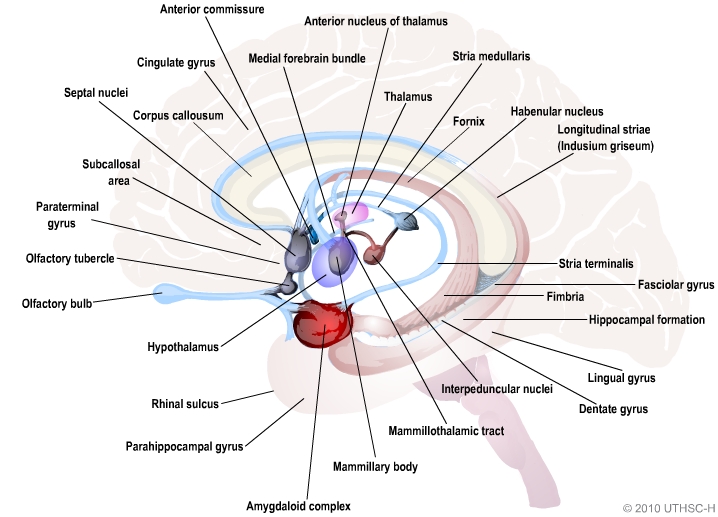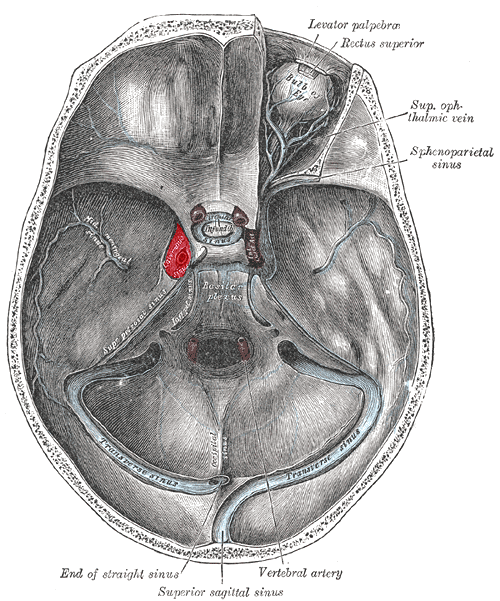Showing posts with label Neuroanatomy. Show all posts
Showing posts with label Neuroanatomy. Show all posts
Saturday, 26 October 2019
Thursday, 14 March 2019
Thalamic Nuclei
Thalamic Nuclei

If you get orientated, they are largely as they say on the tin
Pulvinar is posterior (means cushion- you sit on it with your posterior)
The ventral 'belly' side faces outwards *laterally).


If you get orientated, they are largely as they say on the tin
Pulvinar is posterior (means cushion- you sit on it with your posterior)
The ventral 'belly' side faces outwards *laterally).


Wednesday, 13 March 2019
Parasympathetics
Parasympathetics





| Feature | Sympathetic NS | Parasympathetic NS |
| Summary of responses | Fight or flight | Rest and digest |
| Spinal cord distribution | Thoracolumbar | Craniosacral |
| Preganglionic neurone | Short | Long |
| Preganglionic neurotransmitter | Acetylcholine (Ach, cholinergic) | Acetylcholine (Ach, cholinergic) |
| Postganglionic neurone | Long | Short |
| Postganglionic neurotransmitter | Noradrenaline (NA, adrenergic) in most cases* | Acetylcholine (Ach, cholinergic) |
*Sweat being an exception
Efferent i.e. motor
Afferent i.e. towards the CNS so sensory
Parasympathetic motor efferents—This system is divided into cranial and sacral components, and parasympathetic efferents only synapse with postganglionic cells close to or within target viscera (allowing local discrete responses)
4 main parasympathetic nuclei (III, VII, IX, X) with synapses in 4 ganglia (NB ganglia are outside CNS)
NB Most ganglia are associated with some sensory and sympathetic nerves – these do not synapse in the ganglia, they merely travel through it.
1. Cilliary (parasympathetic eye)
Supplied by fibres from Edinger-Westphal nucleus (a/w CNIII)
Function: pupil constriction and accommodation
2. Pterygopalatine Ganglion (aka sphenopalatine) in pterygopalatine fossa (cries/lubricates nasopharynx)
Supplied by superior salivatory nuclues (a/w CN VII) via GSPN and Vidian nerve.
Function: secretomotor innervation to lacrimal gland, mucous glands of nasal cavity, nasopharynx and palate.

3. Submandibular ganglion (salivates)
Suspended from lingual nerve
Supplied by superior salivatory nucleus (a/w CN VII)
Function: Secretomotor innervation to the submandibular and sublingual salivary glands
4. OTic Ganglion (parOTid - salivates)
Inferior to foramen ovale
Supplied by inferior salivatory nuclues (a/w CN IX)
Innervates parotid

NB Vagus (X) does not innervate head and neck structures - only thorax and abdomen.
| Nucleus | Pre-ganglionic | Ganglion | Post-ganglionic | Target organs |
| Edinger-Westphal (Oculomotor nerve) | Travels with the motor root of the oculomotor nerve | Ciliary ganglion | Travels via the short ciliary nerves | Sphincter pupilliae
Ciliary muscles
|
| Superior salivatory nucleus (Facial nerve) NB VII above IX hence sup and inf (both salivate) | Travels with the greater petrosal nerve and the nerve of the pterygoid canal | Pterygopalatine ganglion | Hitchhikes on branches of the maxillary nerve | Lacrimal gland
Nasopharynx
Palate
Nasal cavity
|
| Travels within the chorda tympani, a branch of the facial nerve | Submandibular ganglion | Fibres travel directly to target organs | Sublingual and submandibular glands | |
| Inferior salivatory nucleus (Glossopharyngeal nerve) | Travels within the lesser petrosal nerve | Otic ganglion | Hitchhikes on the auriculotemporal nerve | Parotid gland |
| Dorsal vagal motor nucleus (vagus nerve) | Travels within the vagus nerve | Many – located within the target organs | n/a | Smooth muscle of the trachea, bronchi and gastro-intestinal tract |
Tuesday, 12 March 2019
Cerebral Venous System
Cerebral Sinuses and Veins
There are 11 venous sinuses in total, between periostial and meningeal layers of dura.
Veins of significance include Thalamostriate, Superior Anastomotic Vein (of Trolard), Internal Cerebral Vein, Great Cerebral Vein (of Galen), Basal Vein (of Rosenthal), Inferior Anastomotic Vein (of Labbe), transverse vein, Middle Cerebral Veins (of Sylvius)- Deep and Superficial, Anterior cerebral vein,

Right transverse sinus is usually dominant and typically receives superficial blood- via continuation of SSS; left TS typically drains deep brain
NB inferior petrosal sinus sampling (to measure ATCH levels) is a clue that this drains pituitary.
Veins are located in subarachnoid space and divided into superficial and deep systems.
Superficial Veins

Trolard, Labbe and Sylvius (superficial) all meet up.

Visual Pathways
Visual Pathways


Blue arrows indicate Meyer's Loop.

Optic nerve is developed from the optic vesicle.
Originates from retinal ganglion cell axons, enters the cranial cavity via optical canal, passing through tendinous ring annulus of Zinn.

"2, 3 n 6" pass within the annulus, n being nasociliary nerve (i.e. V1 branch).

Meyer's loop is anterior, inferior and temporal; central bundle abuts lateral ventricle; the dorsal bundle is superior and parietal (Baum's loop). Meyer's loop produces pie in the sky deficit.
NB Nasal fibres cross at the chiasm, temporal don't (you cross your eyes at your nose).


This demonstrates the geniculate pathway conscious visual processing (incorporating the LGN of the thalamus)
There are also extrageniculate pathways, which project to: pretectal nucleus (midbrain- pupillary reflexes), superior colliculus (midbrain- coordinated reflexive head and eye movements), suprachiasmatic nucleus (hypothalamus- circadian cycles).


Blue arrows indicate Meyer's Loop.

Optic nerve is developed from the optic vesicle.
Originates from retinal ganglion cell axons, enters the cranial cavity via optical canal, passing through tendinous ring annulus of Zinn.

"2, 3 n 6" pass within the annulus, n being nasociliary nerve (i.e. V1 branch).
Meyer's loop is anterior, inferior and temporal; central bundle abuts lateral ventricle; the dorsal bundle is superior and parietal (Baum's loop). Meyer's loop produces pie in the sky deficit.
NB Nasal fibres cross at the chiasm, temporal don't (you cross your eyes at your nose).


This demonstrates the geniculate pathway conscious visual processing (incorporating the LGN of the thalamus)
There are also extrageniculate pathways, which project to: pretectal nucleus (midbrain- pupillary reflexes), superior colliculus (midbrain- coordinated reflexive head and eye movements), suprachiasmatic nucleus (hypothalamus- circadian cycles).

Sunday, 24 February 2019
Cranial Projection and Association Tracts and Limbic System


Bundles implies long association fibres



Corpus callosum fibres



VA- ventral anterior
VL - ventral lateral

NB Lentiform nucleus = GP + putamen
Tegmentum (Lat- Covering). Forms floor of midbrain cf.
Tectum (Lat- Roof). Forms roof of midbrain.
Stria (Lat- Stripe)
Fasciculus (Lat- Bundle)
Tapetum (Lat- Tapestry/rug)
Habenula (Lat- reins). Denotes stalk of pineal gland and neighbouring neurons.


Resembles a tapestry; the carpet of the brain. Primarily formed by decussating fibres of the splenium.
Septal nuclei are by septum pellucidum. Role in pleaseure/reward like Nucleus Accumbus.
Limbic System- a ring of memory and emotion (like a wedding ring).

Simplified:

Deontes a conerstone of memory processing/consolidation

Indusium (tunic/shirt) griseum is membranous layer of grey matter which covers the corpus callosum.
Cavernous Sinus
Cavernous Sinus Anatomy



All are in lateral wall except V1
From superior to inferior III, IV, V1, V2.


Coronal scan through the cavernos sinus. MR contrast-enhanced FIESTA sequence. a, oculomotor nerve; b, trochlear nerve; c, abducens nerve; d, ophthalmic nerve; e, maxillary nerve; f, internal cerebral artery; cavernous segment; g, right optic nerve; h, pituitary gland



All are in lateral wall except V1
From superior to inferior III, IV, V1, V2.


Coronal scan through the cavernos sinus. MR contrast-enhanced FIESTA sequence. a, oculomotor nerve; b, trochlear nerve; c, abducens nerve; d, ophthalmic nerve; e, maxillary nerve; f, internal cerebral artery; cavernous segment; g, right optic nerve; h, pituitary gland
Sunday, 27 January 2019
Middle Cerebral Artery
Middle Cerebral Artery:
Territory:

Supplies most of lateral surface of hemisphere, part of internal capsule (posterior part of anterior limb and anterior part of posterior limb) and basal ganglia.
Origin:
Segments:


M1- ICA to Sylvian fissure (horizontal or Sphenoidal)
M2- Sylvian (within fissure; also Insular) post bifurcation into superior & inferior divisions.
M3- Opercular: Top of fissure to cerebral cortex
M4- Cortical (cortical surface branches)
B

Branches:
NB superficial and deep
M1
Lateral lenticulostriate A. (NB ACA is the more medial vessel)
M2 (NB superior and inferior divisions)
Branches supply temporal lobe and insular cortex, parietal lobe, inferolateral frontal lobe via:
Superior:
Lateral frontobasal A.
Prefrontal sulcas A.
Pre-Rolandic (Precentral) and Rolandic (central) sulcal A.
Inferior:
3 temporal branches (anterior, middle and posterior)
Branch to angular gyrus
2 parietal branches (anterior, posterior)

2-7 appear to be exclusively MCA branches. 1 shared with ACA. 8 PCA also.

M3 and M3
The above branches will have M3 and M4 portions

Subscribe to:
Posts (Atom)






